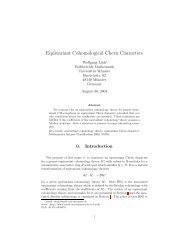Connes-Chern Character for Manifolds with Boundary and ETA ...
Connes-Chern Character for Manifolds with Boundary and ETA ...
Connes-Chern Character for Manifolds with Boundary and ETA ...
You also want an ePaper? Increase the reach of your titles
YUMPU automatically turns print PDFs into web optimized ePapers that Google loves.
CONNES-CHERN CHARACTER AND <strong>ETA</strong> COCHAINS 43<br />
• f ∈ b Γ ∞ cpt((−∞, c) × N; End W ),<br />
• P ∈ Diff b−l (N; W |N ) a differential operator of order b − l on N which is constant<br />
in x-direction.<br />
Note that e −α|X| commutes <strong>with</strong> f. Furthermore, f is uni<strong>for</strong>mly bounded. Thus<br />
∥ ∥ ∥<br />
∥<br />
∥e −α|X| fP ∂xe l −tD2 e β|X| ∥∥p ∥∥e<br />
≤ ‖f‖ −α|X| ∞ P ∂xe l −tD2 e β|X| ∥∥p<br />
. (3.31)<br />
Inside the p-norm is now a tensor product of operators<br />
e −α|X| P ∂ l xe −tD2 e β|X| = ( e −α|X| ∂ l xe −t∆ R<br />
e β|X|) ⊗ ( P e −tA2 )<br />
. (3.32)<br />
Since the p-norm of a tensor product is the product of the p-norms the claim follows from<br />
Proposition 3.5 <strong>and</strong> st<strong>and</strong>ard elliptic estimates <strong>for</strong> the closed manifold N (Propositions<br />
B.5, B.6).<br />
□<br />
3.3. Trace class estimates <strong>for</strong> the JLO integr<strong>and</strong> on manifolds <strong>with</strong> cylindrical<br />
ends. The heat kernel estimate <strong>for</strong> the Dirac operator on the model cylinder<br />
Proposition 3.7 together <strong>with</strong> the comparison result in Section 3.1 will now be used<br />
to obtain trace estimates <strong>for</strong> b-differential operators similar to the one in Proposition<br />
B.8 if the indicial operator of at least one of the operators A 0 , ..., A k vanishes. Let us<br />
mention here that in the following we will use the notation introduced in Section 2, in<br />
particular Eq. (2.3).<br />
Proposition 3.8. Let M = (−∞, 0] × N ∪ N X be a complete manifold <strong>with</strong> cylindrical<br />
ends <strong>and</strong> let D be a Dirac operator on M. Let A 0 , ..., A k ∈ b Diff(M; W ) be b-differential<br />
operators of order a 0 , ..., a k . Assume that <strong>for</strong> at least one index l ∈ {0, ..., k} the indicial<br />
family of A l vanishes. Then <strong>for</strong> t > 0, σ ∈ ∆ k the operator<br />
A 0 e −σ 0tD 2 A 1 · . . . · A k e −σ ktD 2 (3.33)<br />
is trace class. Furthermore, there are the following estimates:<br />
1. For t 0 > 0, ε > 0 there is a constant C(t 0 , ε) such that <strong>for</strong> all σ = (σ 0 , ..., σ k ) ∈ ∆ k ,<br />
σ j > 0,<br />
‖A 0 e −σ 0tD 2 A 1 · . . . · A k e −σ ktD 2 ‖ 1<br />
( k∏<br />
)<br />
≤ C(t 0 , ε) σ −a j/2<br />
j t −a/2−(dim M)/2−ε , 0 < t ≤ t 0 .<br />
j=0<br />
(3.34)<br />
In particular, if a j ≤ 1, j = 0, ..., k, then<br />
‖(A 0 , ..., A k ) √ tD ‖ = O(t−a/2−(dim M)/2−0 ), t → 0 + . (3.35)<br />
2. Assume additionally that D is Fredholm <strong>and</strong> denote by H the orthogonal projection<br />
onto Ker D. Then <strong>for</strong> ε > 0 <strong>and</strong> any 0 < δ < inf spec ess D 2 there is a constant C(δ, ε)<br />
such that <strong>for</strong> all σ ∈ ∆ k , σ j > 0<br />
‖A 0 e −σ 0tD 2 (I − H)A 1 · . . . · A k e −σ ktD 2 (I − H)‖ 1<br />
( k∏<br />
)<br />
≤ C(δ, ε) σ −a j/2<br />
j t −a/2−(dim M)/2−ε e −tδ , <strong>for</strong> all 0 < t < ∞.<br />
j=0<br />
(3.36)

















